-
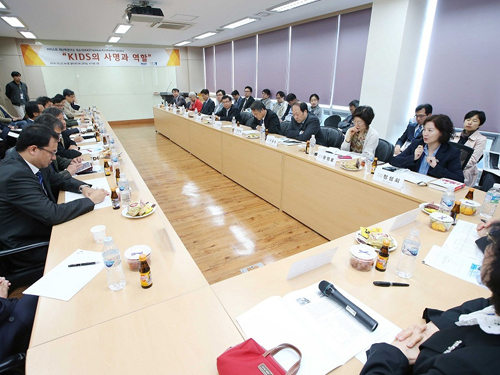 The KAIST Institute for Disaster Studies (KIDS) Opens
About 60 professors from across different departments at KAIST teamed up to make Korean society safer and more secure.
The professors voluntarily created the KAIST Institute for Disaster Studies (KIDS) that will implement the following responsibilities:
- Conduct research on disaster prevention and reduction
- Develop policy on safety and preventive measures for the public
- Establish resilience engineering programs at the university
- Create a platform for social media and machine-based information management
- Develop robot-based search and rescue mission programs
- Conduct disaster risk assessments and develop disaster-recovery plans
- Establish virtual reality programs for training and education
An opening ceremony for the institute took place on campus on October 22, 2014. President Steve Kang of KAIST, Young Jin, a National Assemblyman of the Republic of Korea, Myung-Ja Kim, a former Minister of the Environment of the Republic of Korea, Professor Hee-Kyung Park of the Department of Civil and Environmental Engineering at KAIST, and other dignitaries attended the ceremony.
Professor Park, the Director of KIDS, said, “In recent years, our society has seen many tragic accidents that claimed hundreds of lives. This prompted us to examine the fundamental cause of accidents and forced us to review our current public safety policies and measures. As a result, we were able to identify many reasons, among others, technological problems in public facilities and structures, lack of social policies and systems to protect public safety, and human error.”
He further explained the need for KIDS as follows:
“In order to understand the cause of disasters and prepare remedies, such as how disasters happen, how to respond to them, and what to do for recovery, we need to have a comprehensive approach to the issues from the various perspective of social policy, science, and engineering. KIDS has been created to meet these needs.”
Following the opening ceremony, a seminar was held on the topic of “KIDS’s Mission and Its Role.”
2014.10.24 View 8166
The KAIST Institute for Disaster Studies (KIDS) Opens
About 60 professors from across different departments at KAIST teamed up to make Korean society safer and more secure.
The professors voluntarily created the KAIST Institute for Disaster Studies (KIDS) that will implement the following responsibilities:
- Conduct research on disaster prevention and reduction
- Develop policy on safety and preventive measures for the public
- Establish resilience engineering programs at the university
- Create a platform for social media and machine-based information management
- Develop robot-based search and rescue mission programs
- Conduct disaster risk assessments and develop disaster-recovery plans
- Establish virtual reality programs for training and education
An opening ceremony for the institute took place on campus on October 22, 2014. President Steve Kang of KAIST, Young Jin, a National Assemblyman of the Republic of Korea, Myung-Ja Kim, a former Minister of the Environment of the Republic of Korea, Professor Hee-Kyung Park of the Department of Civil and Environmental Engineering at KAIST, and other dignitaries attended the ceremony.
Professor Park, the Director of KIDS, said, “In recent years, our society has seen many tragic accidents that claimed hundreds of lives. This prompted us to examine the fundamental cause of accidents and forced us to review our current public safety policies and measures. As a result, we were able to identify many reasons, among others, technological problems in public facilities and structures, lack of social policies and systems to protect public safety, and human error.”
He further explained the need for KIDS as follows:
“In order to understand the cause of disasters and prepare remedies, such as how disasters happen, how to respond to them, and what to do for recovery, we need to have a comprehensive approach to the issues from the various perspective of social policy, science, and engineering. KIDS has been created to meet these needs.”
Following the opening ceremony, a seminar was held on the topic of “KIDS’s Mission and Its Role.”
2014.10.24 View 8166 -
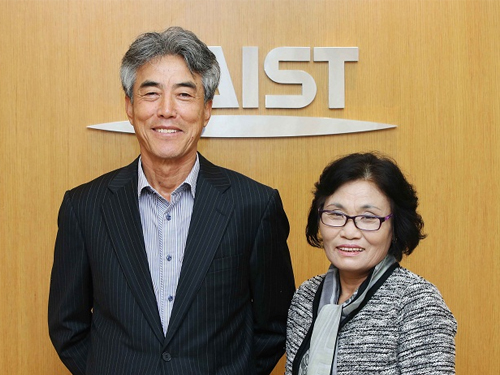 Parents of Alumni Donates to KAIST
Parents of KAIST alumni donated a scholarship of USD 4,800 to the university. A donation ceremony took place at the president’s office on October 21, 2014.
Two sons and the daughter-in-law of Ki-Hong Oh (husband) and Soon-Yi Kim (wife) studied at KAIST. Hwan-Hee Oh and Hwan-Yup Oh graduated with Master’s degrees in Mechanical Engineering in 2005 and 2009, respectively. Jung-Im Min received a Ph.D. in Mechanical Engineering in 2005.
Oh and Kim, who are orange growers in Jeju Island, Korea, said, “We have always appreciated the generous support our children received from KAIST and thought for many years about ways to make a contribution to the development of the university. Although this is a small amount, we are pleased to express our appreciation to KAIST.”
The couple hope that their donation will inspire others in Korea to follow suit and added, “Just like many of the great universities in the west which are supported through donations made by their alumni and people from all walks of life, we would like to see Korean universities also benefit from such a culture and practice.”
President Steve Kang expressed his gratitude to the couple and said, “KAIST will cherish your philanthropic good deeds, and the scholarship will be used to support students as you wish.”
2014.10.22 View 10083
Parents of Alumni Donates to KAIST
Parents of KAIST alumni donated a scholarship of USD 4,800 to the university. A donation ceremony took place at the president’s office on October 21, 2014.
Two sons and the daughter-in-law of Ki-Hong Oh (husband) and Soon-Yi Kim (wife) studied at KAIST. Hwan-Hee Oh and Hwan-Yup Oh graduated with Master’s degrees in Mechanical Engineering in 2005 and 2009, respectively. Jung-Im Min received a Ph.D. in Mechanical Engineering in 2005.
Oh and Kim, who are orange growers in Jeju Island, Korea, said, “We have always appreciated the generous support our children received from KAIST and thought for many years about ways to make a contribution to the development of the university. Although this is a small amount, we are pleased to express our appreciation to KAIST.”
The couple hope that their donation will inspire others in Korea to follow suit and added, “Just like many of the great universities in the west which are supported through donations made by their alumni and people from all walks of life, we would like to see Korean universities also benefit from such a culture and practice.”
President Steve Kang expressed his gratitude to the couple and said, “KAIST will cherish your philanthropic good deeds, and the scholarship will be used to support students as you wish.”
2014.10.22 View 10083 -
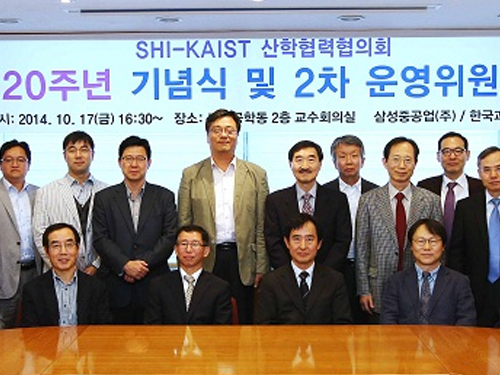 KAIST and Samsung Heavy Industries Celebrate 20 Years of Cooperation
KAIST and Samsung Heavy Industries (SHI) celebrated the twentieth anniversary of their university-industry cooperation in shipbuilding and ocean technology research. Established in 1995, the cooperation has remained steadfast for two decades, even times when Korea suffered gravely from its financial crisis in late 1990s.
A ceremony to commemorate the cooperation took place at the Mechanical Engineering Building on October 17, 2014. About thirty distinguished guests including the Head of the Department of Mechanical Engineering, Professor Choong-Sik Bae, and the chief engineer of SHI Marine Research Institute, Dr. Jong-Soo Seo, participated in the ceremony.
The cooperation programs included appointing advisory professors for technological support, implementing business-based academic courses, offering university-industry wide open lectures, opening regular courses for auditing, and finding possible joint researches. Through this cooperation, Samsung has secured technologies needed for industry, and KAIST has produced students who have real-world experience in industrial fields.
Twenty years of cooperation has produced shining results by running various programs such as technological advice, special lectures, small-scale research projects, consignment research projects, and courses for research and design personnel.
For example, what started as a small-scale research project with USD 4,800 in funding, the LNG (Liquefied Natural Gas) related research has grown into a large-scale research project with a total of USD 2.85 million in funding. As a result, they developed a secondary barrier for LNG carriers which was recognized by Lloyd‘s Register. Their research eventually lowered ship manufacturing costs tremendously.
In 2003, the cooperation project received the presidential citation from the University-Industry Cooperation Competition organized by the Federation of Korean Industries.
KAIST and SHI planned to increase their cooperation to make it Korea’s leading university-industry cooperation program.
Professor Bae said, “Our programs to focus on solving industrial problems have turned out quite successful.” He emphasized that “for this reason, the cooperation even continued during the Asian financial crisis in 1997.”
He added, “By expanding the current cooperation, we aim to make it an exemplary program that contributes to Korea’s shipbuilding and ocean plant industries.”
2014.10.21 View 11533
KAIST and Samsung Heavy Industries Celebrate 20 Years of Cooperation
KAIST and Samsung Heavy Industries (SHI) celebrated the twentieth anniversary of their university-industry cooperation in shipbuilding and ocean technology research. Established in 1995, the cooperation has remained steadfast for two decades, even times when Korea suffered gravely from its financial crisis in late 1990s.
A ceremony to commemorate the cooperation took place at the Mechanical Engineering Building on October 17, 2014. About thirty distinguished guests including the Head of the Department of Mechanical Engineering, Professor Choong-Sik Bae, and the chief engineer of SHI Marine Research Institute, Dr. Jong-Soo Seo, participated in the ceremony.
The cooperation programs included appointing advisory professors for technological support, implementing business-based academic courses, offering university-industry wide open lectures, opening regular courses for auditing, and finding possible joint researches. Through this cooperation, Samsung has secured technologies needed for industry, and KAIST has produced students who have real-world experience in industrial fields.
Twenty years of cooperation has produced shining results by running various programs such as technological advice, special lectures, small-scale research projects, consignment research projects, and courses for research and design personnel.
For example, what started as a small-scale research project with USD 4,800 in funding, the LNG (Liquefied Natural Gas) related research has grown into a large-scale research project with a total of USD 2.85 million in funding. As a result, they developed a secondary barrier for LNG carriers which was recognized by Lloyd‘s Register. Their research eventually lowered ship manufacturing costs tremendously.
In 2003, the cooperation project received the presidential citation from the University-Industry Cooperation Competition organized by the Federation of Korean Industries.
KAIST and SHI planned to increase their cooperation to make it Korea’s leading university-industry cooperation program.
Professor Bae said, “Our programs to focus on solving industrial problems have turned out quite successful.” He emphasized that “for this reason, the cooperation even continued during the Asian financial crisis in 1997.”
He added, “By expanding the current cooperation, we aim to make it an exemplary program that contributes to Korea’s shipbuilding and ocean plant industries.”
2014.10.21 View 11533 -
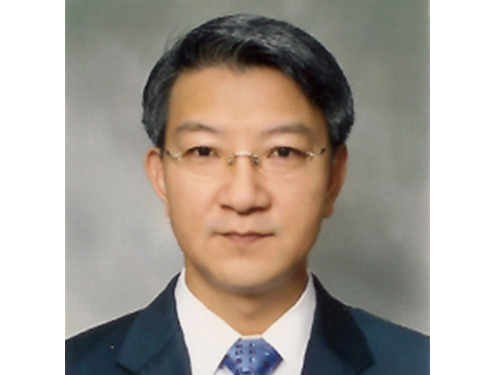 Wuhan University, China, Appoints Distinguished Professor Sang Yup Lee as Honorary Professor
Sang Yup Lee, Distinguished Professor of the Department of Chemical and Biomolecular Engineering at KAIST, has been appointed an honorary professor at Wuhan University in Hubei Province, China. This is the third time that Professor Lee has received an honorary professorship from Chinese academic institutions. The Chinese Academy of Sciences appointed him an honorary professor in 2012, and Shanghai Jia Tong University asked him to serve as an advisory professor in 2013, respectively.
Professor Lee was recognized for his pioneering research in systems metabolic engineering of microorganisms necessary for the development of green chemical industries. He succeeded in producing succinic acid through bacterial fermentation and engineering plastic raw materials in the most effective and economical method for the first time in the world. Professor Lee also developed polylactic acid, a bio-based polymer that allows plastics to be produced through natural and renewable resources, as well as the microbial production of alkanes, an alternative to gasoline that can be produced from fatty acids.
Professor Lee has been actively working as a member of a group of global leaders supported by the World Economic Forum (WEF), serving the Chairman of the Future of Chemicals, Advanced Materials & Biotechnology, Global Agenda Councils, WEF.
Wuhan University is a comprehensive and key national university selected by the Chinese government as a major recipient of state funding for research. It is also known as one of the most beautiful campuses in China.
2014.10.20 View 11319
Wuhan University, China, Appoints Distinguished Professor Sang Yup Lee as Honorary Professor
Sang Yup Lee, Distinguished Professor of the Department of Chemical and Biomolecular Engineering at KAIST, has been appointed an honorary professor at Wuhan University in Hubei Province, China. This is the third time that Professor Lee has received an honorary professorship from Chinese academic institutions. The Chinese Academy of Sciences appointed him an honorary professor in 2012, and Shanghai Jia Tong University asked him to serve as an advisory professor in 2013, respectively.
Professor Lee was recognized for his pioneering research in systems metabolic engineering of microorganisms necessary for the development of green chemical industries. He succeeded in producing succinic acid through bacterial fermentation and engineering plastic raw materials in the most effective and economical method for the first time in the world. Professor Lee also developed polylactic acid, a bio-based polymer that allows plastics to be produced through natural and renewable resources, as well as the microbial production of alkanes, an alternative to gasoline that can be produced from fatty acids.
Professor Lee has been actively working as a member of a group of global leaders supported by the World Economic Forum (WEF), serving the Chairman of the Future of Chemicals, Advanced Materials & Biotechnology, Global Agenda Councils, WEF.
Wuhan University is a comprehensive and key national university selected by the Chinese government as a major recipient of state funding for research. It is also known as one of the most beautiful campuses in China.
2014.10.20 View 11319 -
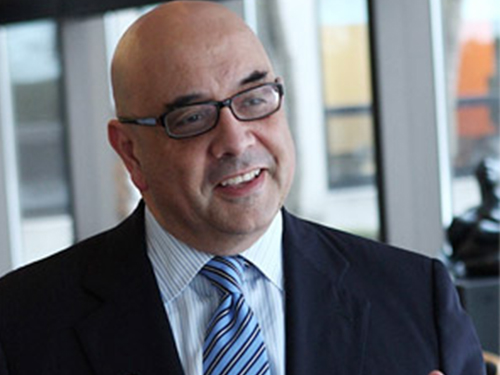 An Artist and Scientist, the Dean of Northwestern University speaks at KAIST
How does an abstract artist look at the world of science? Can art enhance scientific inquiry?
The Department of Chemical and Biomolecular Engineering (CBE), KAIST, invited Professor Julio Mario Ottino to speak at its fourth Annual KAIST CBE Global Distinguished Lectureship from the 15th to 16th October. Professor Ottino is the Dean of the Robert R. McCormick School of Engineering and Applied Science at Northwestern University.
Professor Ottino is a famous artist as well as a scientist. He pursues his disciplines in engineering and art as ways by which an artistic value and scientific truth can coexist. By merging these disciplines, he is praised for adopting balanced engineering education that emphasizes analytical skills and creativity at Northwestern University.
The lecture took place over two days. The topic of the first day was “Creativity” and the next day, “Formalism in Science.”
On the first day, Professor Ottino spoke about “Creativity in Science, Art, and Technology -- How art is separated from science.” He argues that as creativity is essential in art, science, and technology, artistic creativity can help develop scientific and technological creativity.
The next lecture featured “Mixing of Fluids and Solids: Parallels, Divergences, and Lessons.”
He emphasized that the birth of mixing of fluids and researches on granular matter and segregation offered valuable insights and lessons. Although these two topics have developed in different ways, he laid down some examples on how scientific theories have progressed under formalism.
2014.10.16 View 9861
An Artist and Scientist, the Dean of Northwestern University speaks at KAIST
How does an abstract artist look at the world of science? Can art enhance scientific inquiry?
The Department of Chemical and Biomolecular Engineering (CBE), KAIST, invited Professor Julio Mario Ottino to speak at its fourth Annual KAIST CBE Global Distinguished Lectureship from the 15th to 16th October. Professor Ottino is the Dean of the Robert R. McCormick School of Engineering and Applied Science at Northwestern University.
Professor Ottino is a famous artist as well as a scientist. He pursues his disciplines in engineering and art as ways by which an artistic value and scientific truth can coexist. By merging these disciplines, he is praised for adopting balanced engineering education that emphasizes analytical skills and creativity at Northwestern University.
The lecture took place over two days. The topic of the first day was “Creativity” and the next day, “Formalism in Science.”
On the first day, Professor Ottino spoke about “Creativity in Science, Art, and Technology -- How art is separated from science.” He argues that as creativity is essential in art, science, and technology, artistic creativity can help develop scientific and technological creativity.
The next lecture featured “Mixing of Fluids and Solids: Parallels, Divergences, and Lessons.”
He emphasized that the birth of mixing of fluids and researches on granular matter and segregation offered valuable insights and lessons. Although these two topics have developed in different ways, he laid down some examples on how scientific theories have progressed under formalism.
2014.10.16 View 9861 -
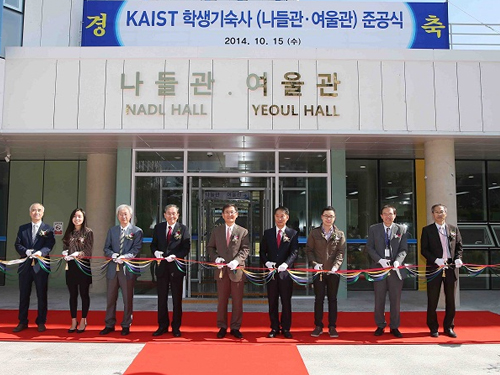 KAIST Opens a New Residence Hall for Students
KAIST has made a great addition to improve life for students on campus.
The faculty and students celebrated the completion of a new dormitory for students on October 15, 2014. About 50 people including President Steve Kang of KAIST, the Dean of the Office of Student Affairs and Policy, and the Dean of the Office of Student Life, attended the ceremony.
The building can accommodate up to 600 students at a time, housing such facilities as 2-or 4-person rooms, meeting rooms, gyms, and laundry rooms. The dormitory is environmentally friendly, with 60% of its heat and cooling system supported by geothermal energy.
Its construction took 18 months, from January 2013 to August 2014, at a cost of 175 million US dollars.
2014.10.15 View 6756
KAIST Opens a New Residence Hall for Students
KAIST has made a great addition to improve life for students on campus.
The faculty and students celebrated the completion of a new dormitory for students on October 15, 2014. About 50 people including President Steve Kang of KAIST, the Dean of the Office of Student Affairs and Policy, and the Dean of the Office of Student Life, attended the ceremony.
The building can accommodate up to 600 students at a time, housing such facilities as 2-or 4-person rooms, meeting rooms, gyms, and laundry rooms. The dormitory is environmentally friendly, with 60% of its heat and cooling system supported by geothermal energy.
Its construction took 18 months, from January 2013 to August 2014, at a cost of 175 million US dollars.
2014.10.15 View 6756 -
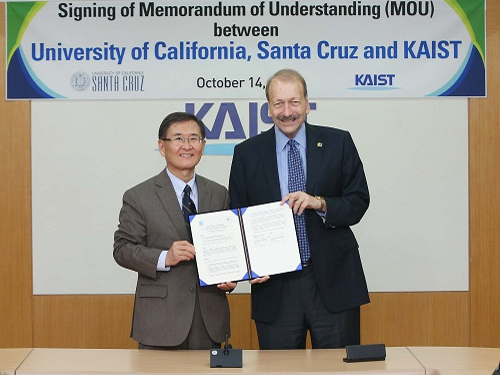 KAIST and University of California, Santa Cruz, Agree to Cooperate
KAIST and the University of California in Santa Cruz signed a memorandum of understanding (MOU) at the KAIST campus on October 14, 2014.
The two institutions agreed to cooperate in the following four areas:
- Research collaboration in genomics and biology
- Academic exchanges in engineering and information communication technology
- Student and faculty exchange programs
- Joint academic workshops and seminars
Following the MOU signing ceremony, Dr. George Blumenthal, the Chancellor of UC Santa Cruz, held a special seminar for KAIST students and faculty, during which he shared some of the success stories made through UC Santa Cruz’s close cooperation with companies in Silicon Valley.
President Steve Kang of KAIST praised the MOU saying, “KAIST and UC Santa Cruz have top-notch research professionals, and the MOU will reinforce their research capability. We hope that the two universities will carry out many research projects that bring significant impact on the world.”
UC Santa Cruz was established in 1965 as a public research university committed to undergraduate education. The university has a total student population of 16,000 (15,375 undergraduates and 1,378 graduates). Offering 60 undergraduate majors, UC Santa Cruz's faculty includes six recipients of Pulitzer Prizes and five MacArthur Genius Awards. The university was ranked the 2nd in the world for research influence in 2012-2013 Times Higher Education rankings.
2014.10.15 View 9526
KAIST and University of California, Santa Cruz, Agree to Cooperate
KAIST and the University of California in Santa Cruz signed a memorandum of understanding (MOU) at the KAIST campus on October 14, 2014.
The two institutions agreed to cooperate in the following four areas:
- Research collaboration in genomics and biology
- Academic exchanges in engineering and information communication technology
- Student and faculty exchange programs
- Joint academic workshops and seminars
Following the MOU signing ceremony, Dr. George Blumenthal, the Chancellor of UC Santa Cruz, held a special seminar for KAIST students and faculty, during which he shared some of the success stories made through UC Santa Cruz’s close cooperation with companies in Silicon Valley.
President Steve Kang of KAIST praised the MOU saying, “KAIST and UC Santa Cruz have top-notch research professionals, and the MOU will reinforce their research capability. We hope that the two universities will carry out many research projects that bring significant impact on the world.”
UC Santa Cruz was established in 1965 as a public research university committed to undergraduate education. The university has a total student population of 16,000 (15,375 undergraduates and 1,378 graduates). Offering 60 undergraduate majors, UC Santa Cruz's faculty includes six recipients of Pulitzer Prizes and five MacArthur Genius Awards. The university was ranked the 2nd in the world for research influence in 2012-2013 Times Higher Education rankings.
2014.10.15 View 9526 -
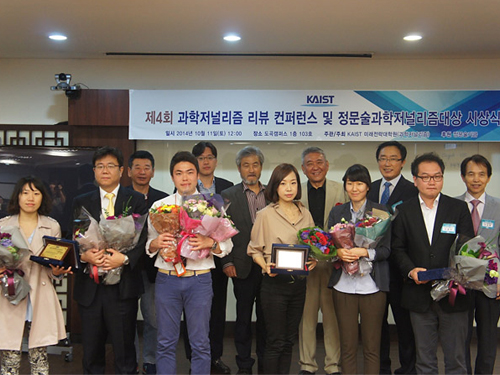 KAIST's Masters of Science Journalism Presents the 4th Annual Moon-Sul Chung Award
The Masters of Science Journalism (MSJ) program at the Graduate School of Future Strategy, KAIST, hosted a conference and presented its fourth annual Moon-Sul Chung Award to the Hankyoreh newspaper at KAIST’s Seoul campus on October 11, 2014.
MSJ organized the conference to review major issues reported in the Korean news in the context of the sciences, for example, how the Korean media covered the tragic accident of the Sewol Ferry, a passenger ship that capsized and eventually sank with hundreds of passengers on board in the waters off the southern coast of Korea on April 16, 2014. Participants of the conference discussed the approaches taken by the media to report science-related issues such as mechanical problems of the ship and technical errors made by the operator.
MSJ conferred its annual award to a Hankyoreh news team which covered the Sewol incident. The award is named for Moon-Sul Chung, a philanthropist who created a scholarship fund for the school in 2011 to recognize news organizations that have striven to report social issues in a fair and balanced manner.
2014.10.14 View 7295
KAIST's Masters of Science Journalism Presents the 4th Annual Moon-Sul Chung Award
The Masters of Science Journalism (MSJ) program at the Graduate School of Future Strategy, KAIST, hosted a conference and presented its fourth annual Moon-Sul Chung Award to the Hankyoreh newspaper at KAIST’s Seoul campus on October 11, 2014.
MSJ organized the conference to review major issues reported in the Korean news in the context of the sciences, for example, how the Korean media covered the tragic accident of the Sewol Ferry, a passenger ship that capsized and eventually sank with hundreds of passengers on board in the waters off the southern coast of Korea on April 16, 2014. Participants of the conference discussed the approaches taken by the media to report science-related issues such as mechanical problems of the ship and technical errors made by the operator.
MSJ conferred its annual award to a Hankyoreh news team which covered the Sewol incident. The award is named for Moon-Sul Chung, a philanthropist who created a scholarship fund for the school in 2011 to recognize news organizations that have striven to report social issues in a fair and balanced manner.
2014.10.14 View 7295 -
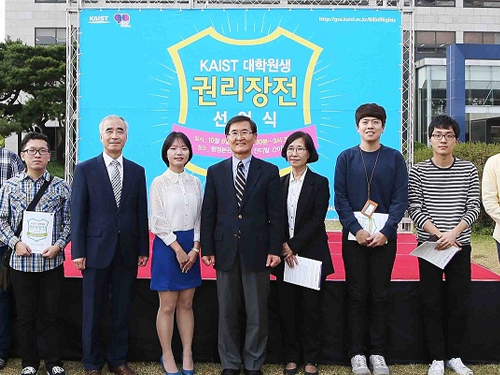 KAIST Introduces a Student Bill of Rights
The Graduate Student Association at KAIST (GSA) established a Bill of Rights for students, outlining student basic beliefs, rights, and obligations. This was the first time for Korean university students to create their own Bill of Rights.
The Bill consists of a total of 21 articles. The preamble of the Bill states individual rights for students, confirming that the Constitution of the Republic of Korea extends to the members of the KAIST community. The Articles stipulate the rights and obligations of students, covering such rights as healthcare, marriage, maternal care, privacy protection, study and research opportunities, and security.
The GSA held a ceremony to inform KAIST members of the Bill of Rights in front of the Main Administration building on October 6, 2014. Approximately 100 students and faculty members, including President Steve Kang, joined the ceremony. They expressed support for students’ efforts to build a better environment conducive to study and research.
Yeon-Ju Kim, the GSA President, said, “The Student Bill of Rights will serve as the first step to raise awareness about our rights and obligations. The Student Association will continue making efforts to provide KAIST students with an opportunity to study and live in a happier and healthier environment.”
2014.10.11 View 7087
KAIST Introduces a Student Bill of Rights
The Graduate Student Association at KAIST (GSA) established a Bill of Rights for students, outlining student basic beliefs, rights, and obligations. This was the first time for Korean university students to create their own Bill of Rights.
The Bill consists of a total of 21 articles. The preamble of the Bill states individual rights for students, confirming that the Constitution of the Republic of Korea extends to the members of the KAIST community. The Articles stipulate the rights and obligations of students, covering such rights as healthcare, marriage, maternal care, privacy protection, study and research opportunities, and security.
The GSA held a ceremony to inform KAIST members of the Bill of Rights in front of the Main Administration building on October 6, 2014. Approximately 100 students and faculty members, including President Steve Kang, joined the ceremony. They expressed support for students’ efforts to build a better environment conducive to study and research.
Yeon-Ju Kim, the GSA President, said, “The Student Bill of Rights will serve as the first step to raise awareness about our rights and obligations. The Student Association will continue making efforts to provide KAIST students with an opportunity to study and live in a happier and healthier environment.”
2014.10.11 View 7087 -
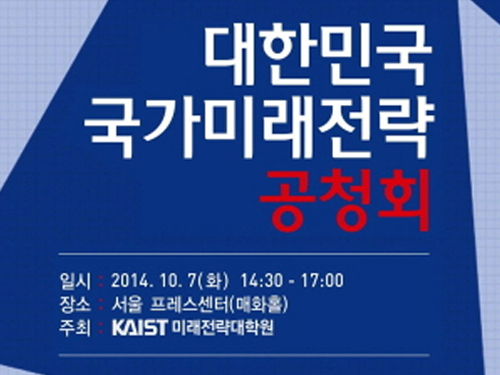 The KAIST Graduate School of Future Strategy Holds a Conference on Strategies for National Development
The Graduate School of Future Strategy (GSFS) at KAIST hosted a conference on strategies to advance Korea further. The conference took place at the Seoul Press Center on October 7, 2014.
GSFS organized the conference to discuss important issues facing Korea such as the global economic crisis, political instability in Northeast Asia, and Korea's aging population as well as ways to resolve these issues through innovations in science and technology.
Seven panelists, mostly professors from GSFS, presented papers on strategies proposed from various perspectives intended to make Korea economically, politically, and culturally stronger in the future.
Professor Kwang-Hyung Lee, Dean of GSFS, said that the results of the conference will be published as a report, to be entitled “Building a Creative Nation Based upon Peace in Asia,” and will be submitted to the Korean government.
2014.10.10 View 6705
The KAIST Graduate School of Future Strategy Holds a Conference on Strategies for National Development
The Graduate School of Future Strategy (GSFS) at KAIST hosted a conference on strategies to advance Korea further. The conference took place at the Seoul Press Center on October 7, 2014.
GSFS organized the conference to discuss important issues facing Korea such as the global economic crisis, political instability in Northeast Asia, and Korea's aging population as well as ways to resolve these issues through innovations in science and technology.
Seven panelists, mostly professors from GSFS, presented papers on strategies proposed from various perspectives intended to make Korea economically, politically, and culturally stronger in the future.
Professor Kwang-Hyung Lee, Dean of GSFS, said that the results of the conference will be published as a report, to be entitled “Building a Creative Nation Based upon Peace in Asia,” and will be submitted to the Korean government.
2014.10.10 View 6705 -
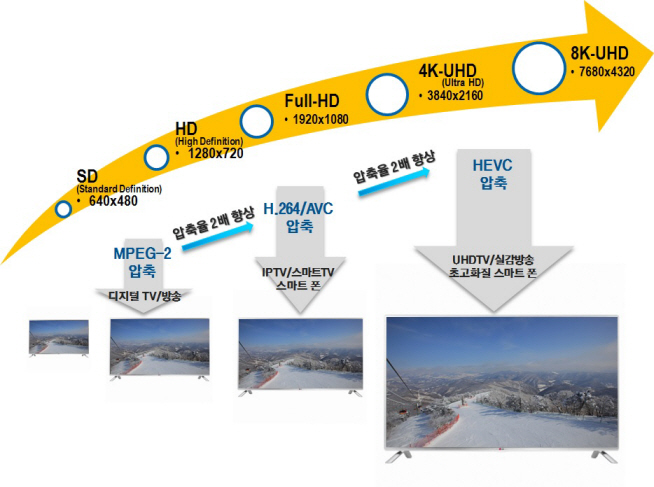 KAIST Registers an Internationally Recognized Standard Patent
A video compression technology, jointly developed by Professor Mun-Chul Kim of the Department of Electrical Engineering at KAIST, the Electronics and Telecommunications Research Institute (ETRI), and the Korean Broadcasting System (KBS), is registered internationally as the standard patent in the next-generation High Efficiency Video Coding (HEVC).
HEVC (H.265) is an international technology standard that compresses large image data for Ultra High Definition (UHD) televisions and smartphones. It has the twice the compression efficiency as that of H.264/AVC which is most commonly used for processing full HD sources. This means that it is able to compress a video file to half the size while maintaining the same image quality.
Although the related market is at a nascent stage, HEVC technology has already been applied to the latest version of televisions and smartphones. Experts predict that the market will grow to USD 200 billion by 2016, and KAIST is expected to receive a royalty payment of USD 9.3 million from this patent.
The International Organization for Standardization (ISO/IEC) established the HEVC standard in January 2013. Also, an international patent pool licensing corporation, MPEG LA announced the HEVC standard patent pool on September 29, 2014.
Professor Joongmyeon Bae, Dean of the Office of University-Industry Cooperation (OUIC) of KAIST, said, “This is an unprecedented case for Korea whereby a core technology developed by a university became an international standard, which has a vast impact on the market.”
President of KAIST, Steve Kang commented, “With its advanced technology, KAIST joined the HEVC standard patent pool as one of the 23 founding members along with Apple, Siemens, and NEC. This is a remarkable achievement.”
Picture 1: Improvements in video compression technology
Picture 2: Comparison of different screen resolutions
2014.10.09 View 15274
KAIST Registers an Internationally Recognized Standard Patent
A video compression technology, jointly developed by Professor Mun-Chul Kim of the Department of Electrical Engineering at KAIST, the Electronics and Telecommunications Research Institute (ETRI), and the Korean Broadcasting System (KBS), is registered internationally as the standard patent in the next-generation High Efficiency Video Coding (HEVC).
HEVC (H.265) is an international technology standard that compresses large image data for Ultra High Definition (UHD) televisions and smartphones. It has the twice the compression efficiency as that of H.264/AVC which is most commonly used for processing full HD sources. This means that it is able to compress a video file to half the size while maintaining the same image quality.
Although the related market is at a nascent stage, HEVC technology has already been applied to the latest version of televisions and smartphones. Experts predict that the market will grow to USD 200 billion by 2016, and KAIST is expected to receive a royalty payment of USD 9.3 million from this patent.
The International Organization for Standardization (ISO/IEC) established the HEVC standard in January 2013. Also, an international patent pool licensing corporation, MPEG LA announced the HEVC standard patent pool on September 29, 2014.
Professor Joongmyeon Bae, Dean of the Office of University-Industry Cooperation (OUIC) of KAIST, said, “This is an unprecedented case for Korea whereby a core technology developed by a university became an international standard, which has a vast impact on the market.”
President of KAIST, Steve Kang commented, “With its advanced technology, KAIST joined the HEVC standard patent pool as one of the 23 founding members along with Apple, Siemens, and NEC. This is a remarkable achievement.”
Picture 1: Improvements in video compression technology
Picture 2: Comparison of different screen resolutions
2014.10.09 View 15274 -
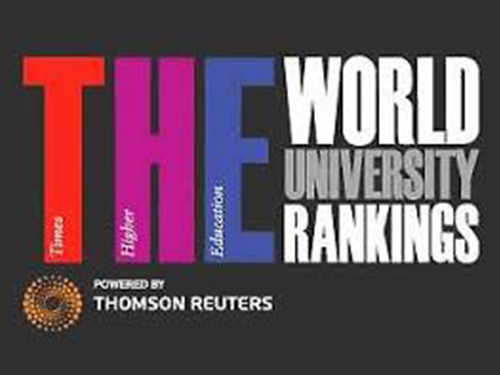 KAIST Ranks 26th in Engineering & Technology and 52nd overall in the Times Higher Education World University Rankings 2014-2015
The 2014-2015 Times Higher Education (THE) World University Rankings were released on October 1, 2014. KAIST took 52nd place in the overall rankings and 26th in the field of engineering and technology.
THE used 13 performance indicators to evaluate universities, grouping them into five areas of teaching, research, citations, industry income, and international outlook.
In recent years, KAIST has seen steady improvements in areas of research, citations, and international outlook. In addition to KAIST, two Korean universities, Seoul National University (50th) and Pohang University of Science and Technology (66th), were included within the top 100 universities.
For details, please visit:
http://www.timeshighereducation.co.uk/world-university-rankings/2014-15/world-ranking.
2014.10.03 View 9971
KAIST Ranks 26th in Engineering & Technology and 52nd overall in the Times Higher Education World University Rankings 2014-2015
The 2014-2015 Times Higher Education (THE) World University Rankings were released on October 1, 2014. KAIST took 52nd place in the overall rankings and 26th in the field of engineering and technology.
THE used 13 performance indicators to evaluate universities, grouping them into five areas of teaching, research, citations, industry income, and international outlook.
In recent years, KAIST has seen steady improvements in areas of research, citations, and international outlook. In addition to KAIST, two Korean universities, Seoul National University (50th) and Pohang University of Science and Technology (66th), were included within the top 100 universities.
For details, please visit:
http://www.timeshighereducation.co.uk/world-university-rankings/2014-15/world-ranking.
2014.10.03 View 9971